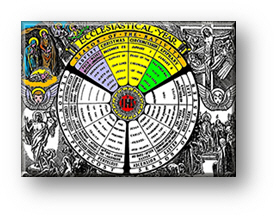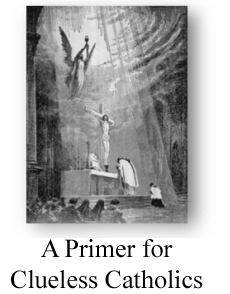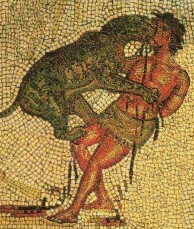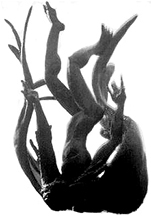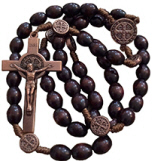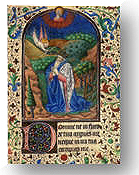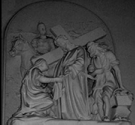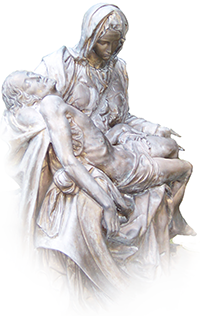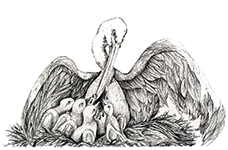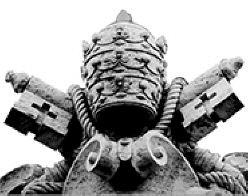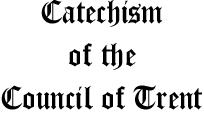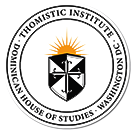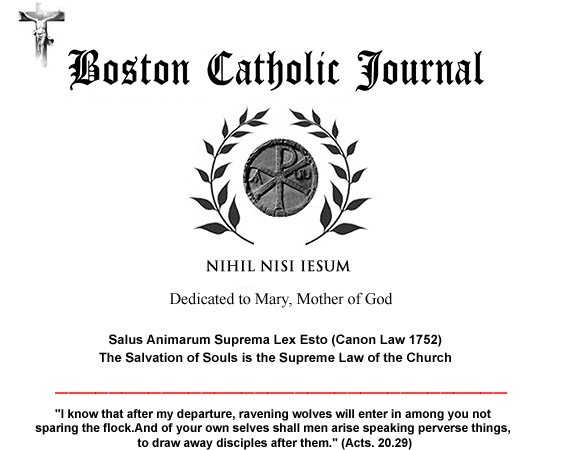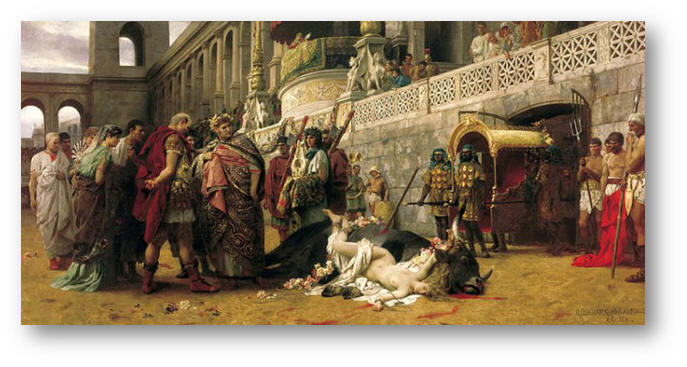|
|
|
While the Martyrology presented is complete, it nevertheless does not present us with great detail concerning the lives of those whose names are forever indited within it, still less the complete circumstances surrounding and leading up to their martyrdom. For greater detail of their lives, the sources now available on the Internet are extensive and we encourage you to explore them.2 As it stands, the Martyrology is eminently suited to a brief daily reflection that will inspire us to greater fervor, even to imitate these conspicuously holy men and women in whatever measure our own state in life affords us through the grace and providence of Almighty God. What more salutary and beneficial way to begin ones day, every day, than by the reading of, and asking intercession from, “the Martyrs whose blood is the seed of the Church”? 3
Beginning January 1st 2012 - Solemnity of Mary, Mother of God — we began presenting the Daily Martyrology on our home page. We hope that you will make new and holy acquaintances — and be inspired by their example to lead lives of heroic sanctity too ... the vocation to which all of us are called by our Holy Mother the Church, the Bride of Christ.
“Omnes sancti Mártyres, oráte pro nobis.” (“All ye Holy Martyrs, pray for us”, from the Litaniae Sanctorum, the Litany of the Saints)
NOTE: This Martyrology contains only those holy martyrs prior to the purging of Saints by Pope Paul VI following Vatican II. These are noted by the abbreviation P2V (prior to Vatican II) preceding their names.
Editor
Boston Catholic Journal
Roman
Martyrology
by Month
___________________________________________________________________________________________________________________
INTRODUCTION TO THE ROMAN MARTYROLOGY
by J. Cardinal Gibbons, Archbishop Baltimore
THE ROMAN MARTYROLOGY is an official and accredited record, on the pages of which are set forth in simple and brief, but impressive words, the glorious deeds of the Soldiers of Christ in all ages of the Church; of the illustrious Heroes and Heroines of the Cross, whom her solemn verdict has beatified or canonized. In making up this long roll of honor, the Church has been actuated by that instinctive wisdom with which the Spirit of God, who abides in her and teaches her all truth, has endowed her, and which permeates through and guides all her actions. She is the Spouse of Christ, without spot or wrinkle or blemish, wholly glorious and undefiled, whom He loved, for whom He died, and to whom He promised the Spirit of Truth, to comfort her in her dreary pilgrimage through this valley of tears, and to abide with her forever. She is one with Him in Spirit and in love, she is subject to Him in all things; she loves what He loves, she teaches and practices what He commands.If the world has its “Legions of Honor”, why should not also the Church of the Living God, the pillar and the ground of the truth? If men who have been stained with blood, and women who have been tainted with vice, have had their memory consecrated in prose and in verse, and monuments erected to their memory, because they exhibited extraordinary talents, achieved great success, or were, to a greater or less extent, benefactors of their race in the temporal order, which passeth away, why should not the true Heroes and Heroines of Jesus, who, imitating His example, have overcome themselves, risen superior to and trampled upon the world, have aspired, in all their thoughts, words, and actions, to a heavenly crown, and have moreover labored with disinterested zeal and self-forgetting love for the good of their fellow-men, have their memories likewise consecrated and embalmed in the minds and hearts of the people of God? If time have its heroes, why should not eternity; if man, why should not God? “Thy friends, O Lord, are exceedingly honored; their principality is exceedingly exalted.” Whom His Father so dearly loved, the world crucified; whom the world neglects, despises, and crucifies, God, through His Church, exceedingly honors and exalts. Their praises are sung forth, with jubilation of heart, in the Church of God for ages on ages.
The wisdom of the Church of God in honoring her Saints is equaled only by the great utility of the practice thus consecrated. The Saints are not merely heroes; they are models. Christ lived in them, and Christ yet speaks through them. They were the living temples of the Holy Ghost, in whose mortal bodies dwelt all the riches of His wisdom and grace. They were in life consecrated human exemplars of divine excellence and perfection. Their example still appeals to our minds and to our hearts, more eloquently even than did their words to the men of their own generation, while they were in the tabernacle of the flesh. Though dead, they still speak. Their relics are instinct with sanctity, and through them they continue to breathe forth the sweet odor of Christ. The immortality into which they have entered still lingers in their bones, and seems to breathe in their mortal remains. As many an ardent, spirit has been induced to rush to the cannon's mouth by reading the exploits of earthly heroes, so many a generous Christian soul has been fired with heavenly ardor, and been impelled to rush to the crown of martyrdom, by reading the lives and heroic achievements of the Saints and Martyrs of Christ. Example, in its silent appeal, is more potent in its influence on the human heart and conduct than are words in their most eloquent utterances.
The Church knows and feels all this, in the Spirit of God with whom she is replenished ; and hence she sets forth, with holy joy and exultant hope, her bright and ever-increasing Calendar of Sanctity of just men and women made perfect and rendered glorious, under her unearthly and sublime teachings. In reading this roll of consecrated holiness, our instinctive conclusion is, precisely that which the great soul of St. Augustine reached at the very crisis of his life, the moment of his conversion "If other men like me have attained to such sanctity, why not I? Shall the poor, the afflicted, the despised of the World, bear away the palm of victory, the crown of immortality, while I lie buried in my sloth and dead in my sins, and thus lose the brilliant and glorious mansion already prepared for me in heaven? Shall all the gifts, which God has lavished upon me, be ingloriously spent and foolishly wasted, in the petty contest for this world's evanescent honors and riches, while the poor and contemned lay up treasures in heaven, and secure the prize of immortal glory? Shall others be the friends of God, whom He delights to honor, while I alone remain His enemy, and an alien from His blessed Kingdom?”
It is a consoling evidence of progress in the spiritual life in this country to find the Martyrology here published, for the first time, in English, and thereby made accessible, in its rich treasures of Sanctity, to all classes of our population. It will prove highly edifying and useful, not only to the members of our numerous religious Communities of both sexes, but also to the laity generally. Every day has here its record of Sanctity; and there is scarcely a Christian, no matter how lowly or how much occupied, who may not be able to daily peruse, with faith and with great profit, the brief page of each day's models of Holiness. These belong to all classes and callings of life; from the throne to the hovel, from the Pontiff to the lowest cleric, from the philosopher to the peasant, from the busy walks of life to the dreary wastes of the desert.
Let all, then, procure and read daily the appropriate portions of this Martyrology. Its daily and pious perusal will console us in affliction, will animate us in despondency, will make our souls glow with the love of God in coldness, and will lift up our minds and hearts from this dull and ever-changing earth to the bright and everlasting mansions prepared for us in Heaven!
Imprimatur, J. Cardinal Gibbons, Archbishop Baltimore, Maryland 1916
______________________________
1 “in the lands of the unbelievers”
2 https://en.wikipedia.org/wiki/List_of_Christian_martyr
https://en.wikipedia.org/wiki/Category:Catholic_martyrs
https://en.wikipedia.org/wiki/List_of_Catholic_martyrs_of_the_English_Reformation
3Tertullian (160-240 A.D.) Apologeticus, Chapter 50
Saints removed from the Roman Martyrology after Vatican II
131 Saints
have been deleted from the
Roman Martyrology by Pope Paul VI’s
motu proprio Mysterii Paschalis
on 14 February 1969. The document states:
“It cannot be denied, however, that in the course of centuries the feasts of the saints have become more and more numerous. The Sacred Synod has therefore decreed [that the removal of saints from the Martyrology — editor] ... is more in harmony with the piety and the needs of our times, and that it better reflects the universality of the Church, in the sense that it proposes the names of [only] the most important saints [in Paul VI's estimation], who present to all the People of God a shining example of sanctity in a variety of ways. It is superfluous to say that this will contribute to the spiritual well-being of the entire Christian world. ... We establish that they will go into effect on January 1, 1970.”
This culturally and ecumenically biased omission of the names of 131 Saints removed does not imply that these saints never existed! It is merely a deletion of their names — not their persons, their sanctity, and their miracles. They have simply become inconvenient for the post-Conciliar Church of Vatican II. With full justification can they — and should they —still be invoked for their intercession for the Church Militant here on earth.
January
Telephorus, 5 January, added in 1602 removed.
Hyginus, 11 January, added in the 12th century removed.
Paul, first hermit, 15 January, added in the 12th century, removed.
Maur, 15 January, added in the 12th century, removed.
Marcellus, 16 January, removed.
Prisca, 18 January, removed.
Maris, Martha, Abachum and Audifax, 19 January, removed.
Canute, 19 January, removed.
Anastasius, 22 January, added in the 12th century, removed.
Emerentiana, 23 January, added in the 9th century, removed.
Peter Nolasco, 28 January, added in 1664, removed.
2nd Feast of Agnes, 28 January, removed.
Martina, 30 January, added in 1635, removed.
February
Andrew Corsini, 4 February, added in 1666, removed.
Dorothy, 6 February, added in the 13th century, removed.
John of Matha, 8 February, added in 1679, removed.
Apollonia, 9 February, added in the 13th century, removed.
Valentine, 14 February, removed.
Faustinus and Jovita, 15 February, added in the 13th century, removed.
Simeon, 18 February, added in the 12th century, removed.
Gabriel of the Sorrowful Virgin, 27 February, added in 1932, removed.
March
Lucius I, 4 March, added in 1602, removed.
Forty Martyrs, 10 March, added in the 12th century, removed.
April
Hermenegild, 13 April, added in 1632, removed.
Tiburtius, Valerian, and Maximus, 14 April, removed.
Anicetus, 17 April, added in the 12th century, removed.
Soter and Caius, 22 April, added in the 13th century, removed.
The Greater Litany, 25 April, removed.
Cletus and Marcellinus, 26 April, added in the 13th century, removed..
Peter of Verona, 29 April, added in 1586, removed.
May
Alexander, Eventius & Theodolus, Juvenal, 3 May removed.
Antoninus; Gordian and Epimachus, 10 May, removed.
Boniface (Martyr), 14 May, removed.
Ubald, 16 May, removed.
Paschal Baylon, 17 May, removed.
Venantius, 18 May, removed.
Peter Celestine; Pudentiana, 19 May, removed.
Urban I, 25 May, removed.
Eleuterius, 26 May, removed.
Felix I, 30 May, removed.
Petronilla, 31 May, removed.
June
Erasmus, 2 June, removed.
Francis Caracciolo, 4 June, removed.
Primus and Felician, 9 June, removed.
John of San Facundo; Basilides, Cyrinus, Nabor and Nazarius, 12 June, removed.
Vitus, Modestus and Crescentia, 15 June, removed.
Gregory Barbarigo, 17 June, removed.
Mark and Marcellianus, 18 June, removed.
Juliana Falconieri; Gervase and Protase, 19 June, removed.
Silverius, 20 June, removed.
Vigil of the Nativity of John the Baptist, 23 June, removed.
William, 25 June, removed.
John and Paul, 26 June, removed.
Vigil of Peter and Paul, 28 June, removed.
Commemoration of Paul, 30 June, removed.
July
Processus and Martinian, 2 July, removed.
Seven Holy Brothers; Rufina and Secunda, 10 July, removed.
Pius I, 11 July, removed.
John Gualbert; Nabor and Felix, 12 July, removed.
Alexius, 17 July, removed.
Symphorosa and her seven Sons, 18 July, removed.
Margaret of Antioch, 20 July, removed.
Praxedes, 21 July, removed.
Apollinaris, 23 July, removed.
Liborius, 23 July, removed.
Christina 24 July, removed.
Christopher, 25 July, removed.
Pantaleon, 27 July, removed.
Nazarius and Celsus, Victor I, Innocent I, 28 July, removed.
Felix, Simplicius, Faustinus and Beatrice, 29 July, removed.
Abdon and Sennen, 30 July, removed.
August
Holy Machabees, 1 August, removed.
Stephen I, 2 August, removed.
Donatus, 7 August, removed.
Cyriacus, Largus and Smaragdus, 8 August, removed.
Romanus; Vigil of Laurence, 9 August, removed.
Tiburtius and Susanna, 11 August, removed.
Eusebius; Vigil of Assumption, 14 August, removed.
Hyacinth of Poland, 17 August, removed.
Agapitus, 18 August, removed.
Timothy and Companions, 22 August, removed.
Philip Benizi, 23 August, removed.
Zephyrinus, 26 August, removed.
Hermes, 28 August, removed.
Sabina, 29 August, removed.
Felix and Adauctus, 30 August, removed.
Raymond Nonnatus, 31 August, removed.
September
Giles; Twelve Holy Brothers, 1 September, removed.
Laurence Justinian, 5 September, removed.
Hadrian, 8 September, removed.
Gorgonius, 9 September, removed.
Nicholas of Tolentino, 10 September, removed.
Protus and Hyacinth, 11 September, removed.
Name of Mary, 12 September, duplicates Birth of Mary, removed.
Nicomedes, 15 September, removed.
Euphemia; Lucy and Geminianus, 16 September, removed.
Stigmata of Francis, 17 September, duplicates 4 October, removed.
Joseph of Cupertino, 18 September, removed.
Eustace and Companions, 20 September, removed.
Thomas of Villanova; Maurice and Companions, 22 September, removed.
Linus, Thecla; 23 September, removed.
Our Lady of Ransom, 24 September, removed.
Cyprian and Justina, 26 September, removed.
October
Remigius, 1 October, removed.
Placid and Companions, 5 October, removed.
Mark (Pope), 7 October, removed.
Sergius, Bacchus, Marcellus, Apulleius, 8 October, removed.
Francis Borgia, 10 October, removed.
Edward, 13 October, removed.
Peter of Alcantara, 19 October, removed.
Hilarion; Ursula and Companions, 21 October, removed.
Chrysanthus and Daria, 25 October, removed.
Evaristus, 26 October, removed.
November
Vitalis and Agricola, 4 November, removed.
Holy Four Crowned Martyrs, 8 November, removed.
Theodore, 9 November, removed.
Andrew Avellino; Tryphon, Respicius and Nympha, 10 November, removed.
Mennas, 11 November, removed.
Didacus of Alcala, 13 November, removed.
Gregory Thaumaturgus, 17 November, removed.
Felix of Valois, 20 November, removed.
Felicitas, 23 November, removed.
Chrysogonus, 24 November, removed.
Catherine, 25 November, removed.
Saturninus, 29 November, removed.
December
Viviana, 2 December, removed.
Barbara, 4 December, removed.
Sabbas, 5 December, removed.
Melchiades, 10 December, removed.
Anastasia, 25 December, removed.
Totally Faithful to the Sacred Deposit of Faith entrusted to the Holy See in Rome
“Scio opera tua ... quia modicum habes virtutem, et servasti verbum Meum, nec non negasti Nomen Meum”
“I know your works ... that you have but little power, and yet you have kept My word, and have not denied My Name.” (Apocalypse 3.8)Copyright © 2004 - 2026 Boston Catholic Journal. All rights reserved. Unless otherwise stated, permission is granted by the Boston Catholic Journal for the copying and distribution of the articles and audio files under the following conditions: No additions, deletions, or changes are to be made to the text or audio files in any way, and the copies may not be sold for a profit. In the reproduction, in any format of any image, graphic, text, or audio file, attribution must be given to the Boston Catholic Journal.

